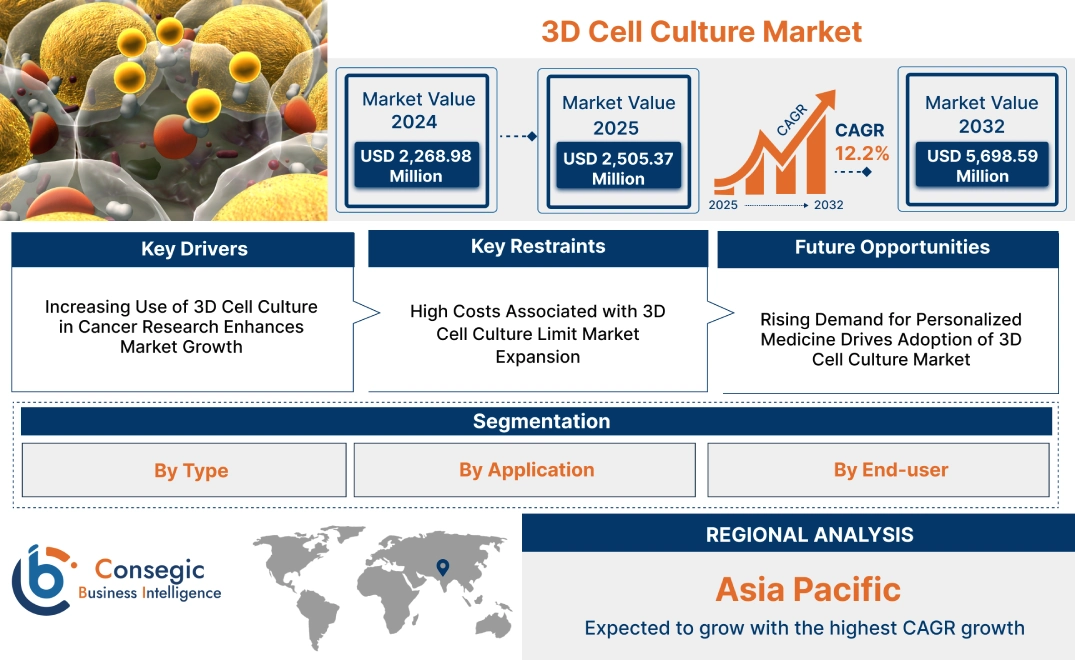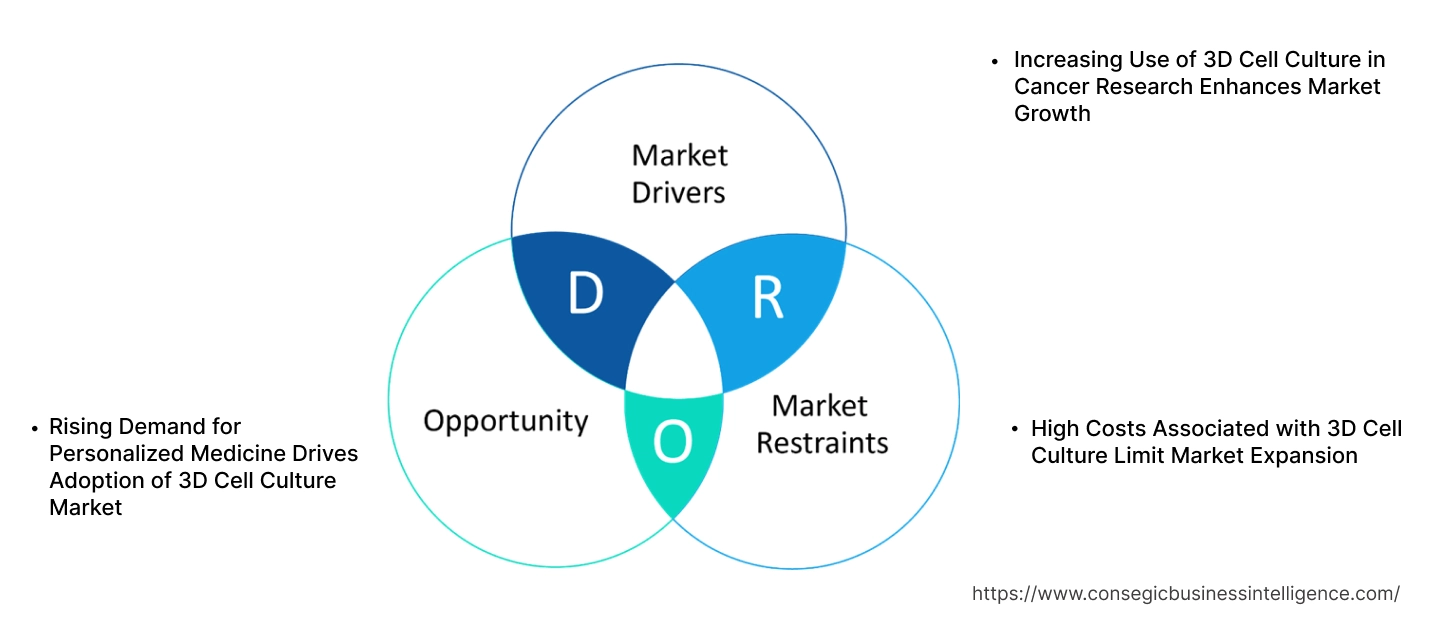- Summary
- Table Of Content
- Methodology
3D Cell Culture Market Size:
3D Cell Culture Market size is estimated to reach over USD 5,698.59 Million by 2032 from a value of USD 2,268.98 Million in 2024 and is projected to grow by USD 2,505.37 Million in 2025, growing at a CAGR of 12.2% from 2025 to 2032.
3D Cell Culture Market Scope & Overview:
3D cell culture is an advanced technology that enables the cultivation of cells in an artificial, three-dimensional environment. This method simulates the natural cell environment more accurately than traditional two-dimensional cultures, supporting more realistic cell behavior and interactions. Key properties include enhanced cell viability, improved differentiation, and precise tissue-like structures. Benefits of 3D cell culture include more predictive models for drug discovery, reduced dependency on animal testing, and improved outcomes in personalized medicine. Applications span multiple fields, including cancer research, regenerative medicine, and toxicology. End-use industries primarily involve biotechnology, pharmaceuticals, and academic research institutions focusing on innovative and accurate cellular studies.
Key Drivers:
Increasing Use of 3D Cell Culture in Cancer Research Enhances Market Growth
The rising use of 3D cell culture market opportunity, the technology in cancer research drives market growth by providing more accurate models for studying cancer cell behavior and drug responses. Unlike traditional 2D cell cultures, 3D cell cultures mimic the complex structure and environment of human tissues, allowing researchers to observe cancer cells in conditions that closely resemble those in the human body. This realistic modeling significantly improves the predictive value of drug efficacy and toxicity studies, supporting faster and more reliable drug development for cancer treatment. For example, researchers using 3D cultures have observed more precise responses to chemotherapy drugs, which can better inform clinical strategies. Consequently, the adoption of 3D cell culture in cancer research is accelerating, enhancing its demand in biotechnology and pharmaceutical industry focused on innovative cancer therapies.
Key Restraints:
High Costs Associated with 3D Cell Culture Limit Market Expansion
The high costs associated with 3D cell culture market growth systems restrain, especially among small to mid-sized research institutions and startups with limited budgets. Compared to traditional 2D culture methods, 3D cell culture systems require specialized materials, advanced scaffolding, and bioreactors, all of which significantly increase operational expenses. Additionally, the need for skilled personnel to handle complex 3D models and interpret results adds to overall costs, further limiting accessibility for many organizations. For instance, implementing 3D cell culture technology in standard labs often requires substantial investment in equipment and training, which not all institutions can afford. These cost constraints impede broader adoption, particularly in emerging markets, thereby restricting overall 3D cell culture market expansion.
Future Opportunities :
Rising Demand for Personalized Medicine Drives Adoption of 3D Cell Culture Market
The growing demand for personalized medicine creates a significant opportunity for the 3D cell culture market trend, as this technology enables more precise, patient-specific cell models. 3D cell cultures allow researchers to cultivate cells derived from individual patients, supporting customized treatment planning and improving therapy outcomes. In personalized oncology, for example, 3D cultures can simulate a patient's unique tumor environment, allowing clinicians to test drug responses before administering treatment. This application highlights the potential of 3D cell culture to improve personalized treatment approaches, thereby driving 3D cell culture market share as healthcare providers increasingly focus on tailored therapeutic solutions.
3D Cell Culture Market Segmental Analysis :
By Type:
Based on type, the market is segmented into Scaffold-Based, Scaffold-Free, Microfluidics, Magnetic & Bioprinted.
The scaffold-based accounted for the largest share 3D Cell Culture market share in the year 2024.
- Scaffold-based 3D cell culture market systems are widely used because of its trends as they are closely replicate in vivo cell environments, providing support for cell adhesion, proliferation, and differentiation.
- In these systems, cells are grown on synthetic or natural matrices that mimic the extracellular environment, creating tissue-like structures that accurately represent real cellular interactions.
- This approach is essential for studying complex biological processes, and it is highly effective for drug discovery and regenerative medicine applications.
- For example, scaffold-based systems allow for precise drug testing in cancer and toxicity studies, providing models that predict drug responses more reliably than traditional methods.
- As pharmaceutical and biotechnology industries invest heavily in R&D for cell culture applications, scaffold-based 3D culture remains the preferred choice for a variety of research and therapeutic applications, making this segment the largest revenue contributor to the 3D cell culture market demand.
The magnetic and bioprinted segment anticipated to register the fastest CAGR during the forecast period.
- Magnetic 3D cell culture uses magnetic fields to assemble cells into three-dimensional structures, offering better control and leveraging its trends over cell aggregation and spatial organization. This technology is increasingly adopted for creating more physiologically relevant models for disease studies, drug testing, and regenerative medicine.
- Bioprinted 3D cell culture enables the precise deposition of cells and biomaterials in a layer-by-layer manner to replicate complex tissue architectures. This technology is gaining traction in regenerative medicine, organ development, and personalized therapeutic solutions.
- Applications for this segment include creating organoids, tissue scaffolds, and advanced disease models for preclinical drug screening and personalized medicine. These methods are also being explored for organ and tissue regeneration.
- For instance, magnetic levitation has been used for rapid tumor spheroid formation, while bioprinting has been explored for constructing functional tissue models for drug efficacy testing and disease modeling.
- As technological advancements in magnetic and bioprinting methods continue, including higher precision and enhanced biomaterial compatibility, this segment is expected to witness substantial growth.
- Growing interest in patient-specific solutions, along with the increasing demand for realistic tissue models for drug discovery and toxicology studies, positions the Magnetic & Bioprinted 3D Cell Culture segment as a transformative area in the 3D cell culture industry.
By Application:
Based on application, the market is segmented into cancer research, drug discovery, stem cell research, and tissue engineering.
The cancer research segment accounted for the largest revenue share in 2024.
- Cancer research drives a significant portion of the demand for 3D cell culture, as 3D models provide a realistic environment for studying cancer cell behavior, interactions, and responses to treatments.
- These models replicate the complex tumor microenvironment, allowing researchers to examine the impact of therapies, cellular responses, and drug resistance with a high degree of accuracy.
- 3D cultures are particularly valuable in testing targeted therapies and chemotherapy treatments, where the effectiveness and safety of potential drugs are critical.
- For example, 3D cell culture systems allow for the testing of cancer drugs in a setting that closely resembles a patient’s tumor environment, providing reliable insights into the drugs’ potential success in clinical trials.
- Given the continued funding and focus on oncology research, the cancer research segment remains the dominant contributor to revenue within the 3D cell culture market expansion.
The tissue engineering segment is anticipated to register the fastest CAGR during the forecast period.
- Tissue engineering represents a growing area for 3D cell culture applications, driven by the ability of 3D cultures to support the formation of functional, scaffold-free tissue structures.
- These engineered tissues have a wide range of applications, including wound healing, organ repair, and regenerative therapies.
- By using patient-specific cells to grow tissue constructs, 3D cell culture technology enables the creation of personalized therapies that can be tailored to individual needs.
- Advances in this field are accelerating the development of artificial organs and tissue grafts, with increasing interest from both clinical and commercial industry.
- For example, 3D cultures allow researchers to create skin grafts for burn victims or even bioengineered organs that could one day be used for transplants.
- With the rising demand for tissue engineering solutions in regenerative medicine shows significant trends, this segment is poised for rapid surge, benefiting from advancements in cell culture technologies and increasing investment in healthcare innovation.
By End-User:
Based on end-user, the 3D cell culture market is segmented into biotechnology and pharmaceutical companies, academic and research institutes, and hospitals and diagnostic centers.
The biotechnology and pharmaceutical companies segment accounted for the largest revenue share of 43.60% in 2024.
- Biotechnology and pharmaceutical companies are the primary users of 3D cell culture systems, leveraging them extensively for drug discovery, toxicity testing, and precision medicine applications.
- These companies rely on 3D cultures to create more accurate and predictive models that can accelerate drug development and reduce reliance on animal testing.
- By providing a realistic cellular environment, 3D cell cultures allow pharmaceutical researchers to test drug responses in vitro with results that closely predict human responses.
- For instance, 3D cell cultures are used in high-throughput screening for cancer drugs, where their reliable, tissue-like structure enhances predictive outcomes.
- The significant R&D investments from biotech and pharma firms in cell culture technologies make this segment the largest revenue contributor due to rapid trends, reflecting the growing reliance on innovative cell models for effective drug development.
The academic and research institutes segment is anticipated to register the fastest CAGR during the forecast period.
- Academic and research institutes represent a rapidly growing end-user segment within the 3D cell culture market analysis as they adopt these advanced culture systems to conduct cutting-edge research in cell biology, genomics, and personalized medicine.
- These institutions benefit from 3D cell culture models for studying complex biological interactions, disease mechanisms, and drug responses in conditions that closely mimic human physiology.
- For example, academic researchers use 3D cell culture to study neurodegenerative diseases in a controlled environment, observing cell behavior in a structure that resembles actual brain tissue.
- As government and private funding continues to support research in cellular and molecular biology, the adoption of 3D cell culture systems is accelerating among research institutes.
- This analysis of segmental trends shows it is expected to experience significant developmental trends as these institutions increasingly utilize 3D culture technologies to enhance the depth and relevance of their research findings.
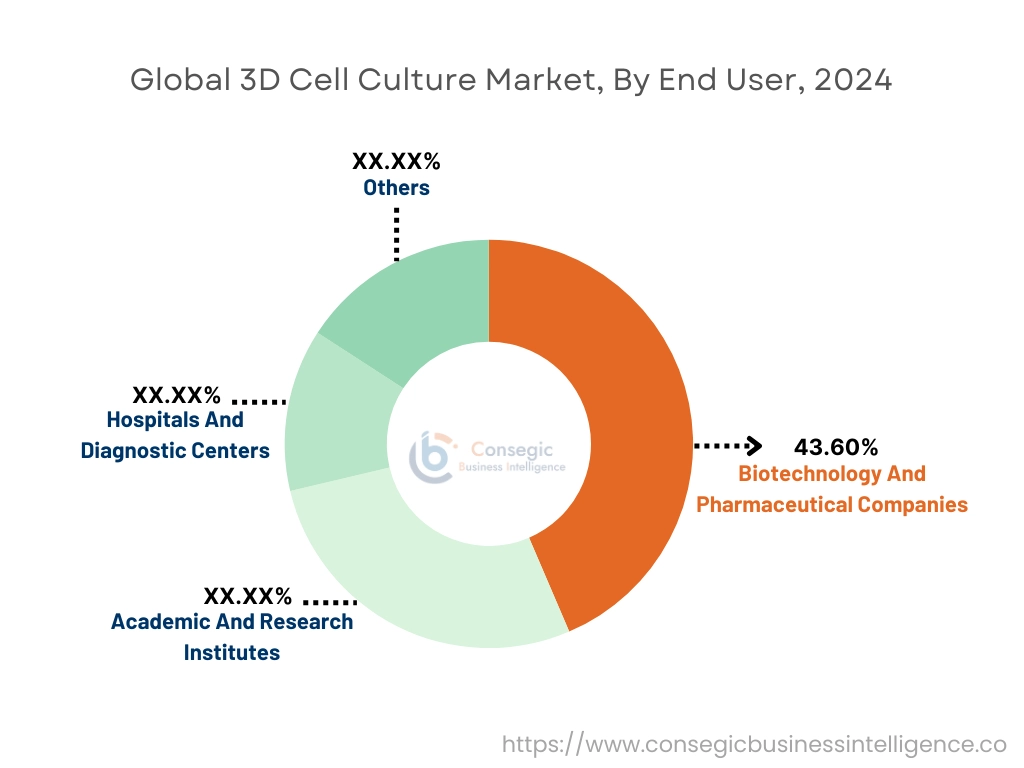
Regional Analysis:
Based on regions, the market is segmented into North America, Asia Pacific, Africa and the Middle East, Europe and Latin America.
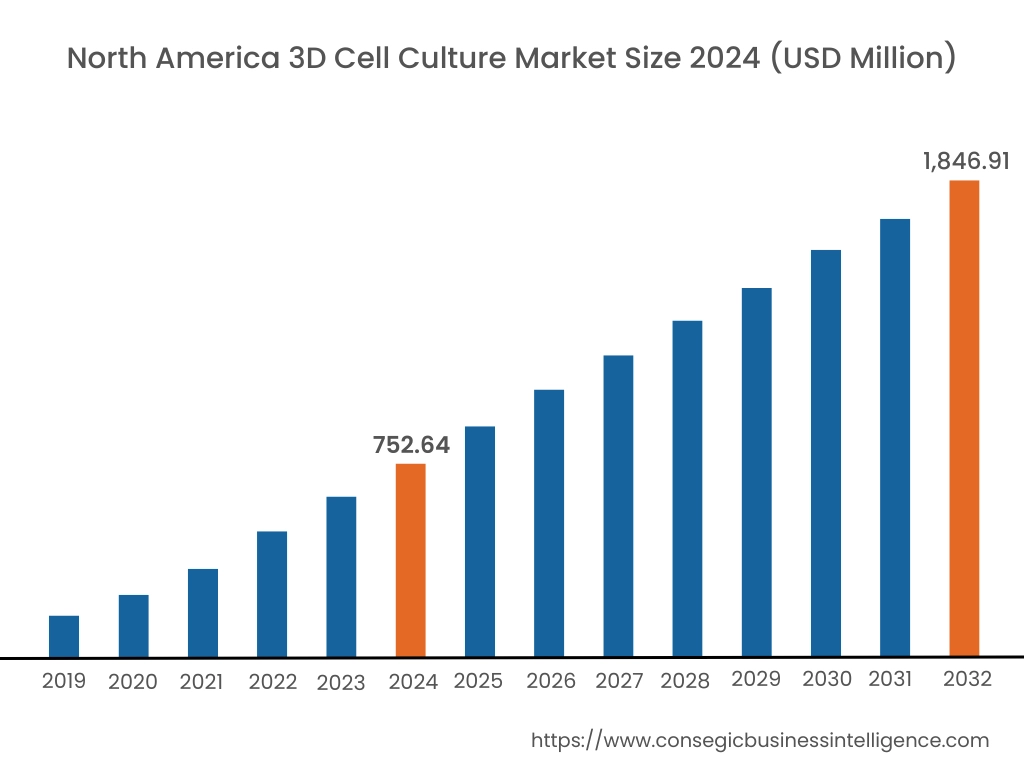
In 2024, North America was valued at USD 752.64 Million and is expected to reach USD 1,846.91 Million in 2032. In North America, the U.S. accounted for the highest share of 71.25% during the base year of 2024. The 3D cell culture market rise in North America is driven by significant R&D investments in biotechnology and pharmaceuticals, particularly in the U.S., where major companies and research institutions are adopting 3D cell culture systems for advanced drug discovery and cancer research. High healthcare spending and a favorable regulatory environment also support the region’s growth, as do government initiatives encouraging innovation in personalized medicine and regenerative therapies.
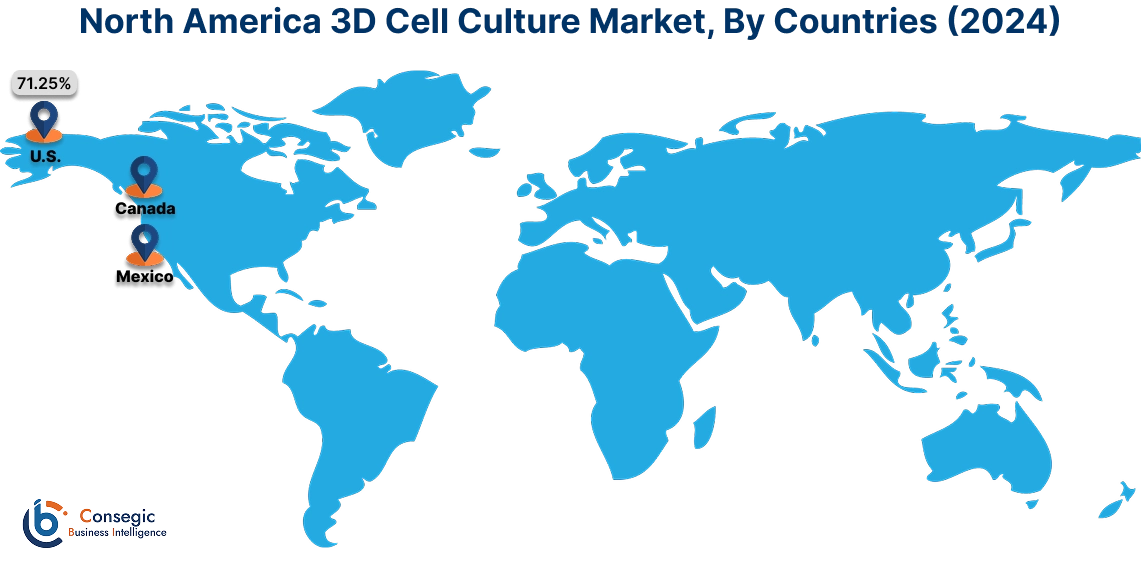
In Asia Pacific, the market is experiencing the fastest growth with a CAGR of 12.7% over the forecast period. Asia-Pacific is experiencing rapid surge in the 3D cell culture market trend due to increasing investment in biomedical research, a growing pharmaceutical sector, and rising awareness of advanced cell culture techniques. The analysis shows countries like China, Japan, and South Korea are expanding research activities in areas such as cancer and stem cell therapy, supported by government funding and academic collaborations. Additionally, cost-effective production capabilities make this region attractive for clinical trials and biomanufacturing.
In Europe, the 3D cell culture market demand is supported by a strong emphasis on reducing animal testing, which drives the adoption of alternative in vitro models. Key countries like Germany, the UK, and France are advancing in drug screening and tissue engineering research, backed by government grants and private investment. The regional analysis shows, European Union’s stringent regulatory standards for drug efficacy and safety testing also encourage the adoption of 3D cell cultures in the region.
The 3D cell culture market opportunity in the Middle East and Africa is gradually expanding as governments and private entities invest in healthcare infrastructure, although adoption remains limited to a few research institutes and universities as per the analysis. The, UAE and South Africa show the most promise due to ongoing efforts to establish biomedical research hubs. Additionally, an increasing focus on cancer research is contributing to the demand for 3D cell culture models in select facilities.
In Latin America, Brazil and Mexico lead the 3D cell culture market growth, driven by an increase in medical research activities and the growing presence of pharmaceutical companies in the region. The analysis displays governmental initiatives aimed at improving healthcare research infrastructure and increasing investment in biotechnology are facilitating flobal 3D cell culture market. However, limited funding and a lack of specialized facilities still pose challenges to widespread adoption.
Major Key Players:
The global 3D cell culture market is highly competitive with major players providing products and services to the national and international markets. Key players are adopting several strategies in research and development (R&D), product innovation, and end-user launches to hold a strong position in the 3D cell culture market. Key players in the 3D cell culture market industry include-
- Thermo Fisher Scientific Inc. (United States)
- Corning Incorporated (United States)
- 3D Biotek LLC (United States)
- Avantor, Inc. (United States)
- Tecan Trading AG (Switzerland)
- Merck KGaA (Germany)
- Lonza Group AG (Switzerland)
- Kuraray Co., Ltd. (Japan)
- Greiner Bio-One International GmbH (Austria)
- ReproCELL Inc. (Japan)
Recent Industry Developments :
Product Launches:
- In October 2022, Corning introduced the Elplasia 12K Flask, designed with a specialized micro cave geometry to streamline the formation, culture, treatment, assessment, and collection of spheroids. This innovative flask can produce around 12,000 uniformly sized and shaped spheroids per flask, yielding 125 times more than standard 96-well spheroid plates.
3D Cell Culture Market Report Insights :
| Report Attributes | Report Details |
| Study Timeline | 2019-2032 |
| Market Size in 2032 | USD 5,698.59 Million |
| CAGR (2025-2032) | 12.2% |
| By Type |
|
| By Application |
|
| By End-User |
|
| By Region |
|
| Key Players |
|
| North America | U.S. Canada Mexico |
| Europe | U.K. Germany France Spain Italy Russia Benelux Rest of Europe |
| APAC | China South Korea Japan India Australia ASEAN Rest of Asia-Pacific |
| Middle East and Africa | GCC Turkey South Africa Rest of MEA |
| LATAM | Brazil Argentina Chile Rest of LATAM |
| Report Coverage |
|
Key Questions Answered in the Report
How big is the 3D Cell Culture Market? +
3D Cell Culture Market size is estimated to reach over USD 5,698.59 Million by 2032 from a value of USD 2,268.98 Million in 2024 and is projected to grow by USD 2,505.37 Million in 2025, growing at a CAGR of 12.2% from 2025 to 2032.
What are the major factors driving the growth of the 3D Cell Culture Market? +
Growth is driven by increased demand for personalized medicine, advancements in cancer research, the need for accurate drug testing models, and reduced reliance on animal testing.
What are the primary applications of 3D cell culture? +
Applications include cancer research, drug discovery, stem cell research, and tissue engineering. These cultures are critical for developing realistic cell models, improving drug testing, and exploring regenerative therapies.
Which region leads the 3D Cell Culture Market? +
North America leads the market, with the U.S. accounting for the largest share due to strong R&D investments, high healthcare spending, and advanced pharmaceutical and biotechnology industries.
